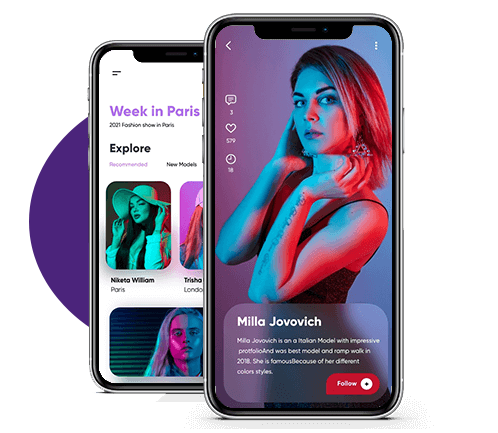The Future of Mobile Commerce: Exploring the Impact of On-Demand App Services on Consumer Behavior
M-commerce, also referred to as mobile commerce, has made significant advancements since its inception. As the use of smartphones and other mobile devices has increased, mobile commerce has become an integral part of our lives. Mobile commerce has improved with the appearance of on-demand apps, allowing users to instantly access goods and services from any location at any time. In the following stage, we’ll talk about how on-demand app services affect consumer behavior and the future of mobile commerce.
Introduction: What are on-demand app development Services?
Consumers can instantly access on-demand services whenever they need them. These services can range from meal delivery services like DoorDash and GrubHub to ride-hailing services like Uber and Lyft, and they are often accessed through mobile apps. Because they
allow customers to obtain what they want when they want it, and on-demand app development services have become increasingly popular.
What is Mobile Commerce?
A mobile device such as a smartphone or tablet is used for mobile commerce, which is the purchasing and selling of products and services. More people now have access to mobile devices and the internet, which has increased the popularity of mobile commerce. Online shopping, mobile banking, and mobile payments are just a few of the various forms of mobile business.
The Rise of On-Demand Services
On-demand solutions is those that provide instant access to products and services, often through a mobile app or website. Examples of on-demand app services include ride-hailing services like Uber and Lyft, food delivery services like DoorDash and Uber Eats, and home cleaning services like Handy and TaskRabbit. On-demand app developers have become increasingly popular in recent years, with consumers valuing the convenience and speed they offer.
Impact on Consumer Behavior
The rise of on-demand services has had a significant impact on consumer behavior. One of the most significant changes is the shift towards instant gratification. Consumers have become accustomed to being able to access products and services instantly, without having to wait for delivery or visit a physical store. This has led to a decrease in patience and an increase in demand for fast, efficient services.
Convenience
On-demand app services are very popular because of how convenient they are. Customers can rapidly request services via their cell phones without leaving their homes or workplaces and have them delivered. Customers now value the convenience that personalized on-demand services offer, which has increased demand for these services.
Speed
On-demand features are also popular because they are fast. Consumers can order services and have them delivered quickly, often within minutes. This has led to an increase in demand for on-demand app services, as consumers value the speed that these services provide.
Cost
On-demand services are often more expensive than traditional services, but consumers are willing to pay more for the convenience and speed that these services provide. This has led to an increase in demand for on-demand services, as consumers are willing to pay a premium for these services.
Another impact of on-demand services is the rise of the sharing economy. Many on-demand services, such as ride-hailing and home cleaning, are provided by individuals rather than traditional businesses. This has led to the creation of new job opportunities and a shift towards more flexible working arrangements. Consumers are also becoming more comfortable with the idea of sharing resources, such as rides or homes, with strangers.
The Future of Mobile Commerce
The rise of on-demand solutions has paved the way for the future of mobile commerce. The following are some trends we might anticipate in the upcoming years:
Increased Personalization

As on-demand services continue to evolve, we can expect to see a greater emphasis on personalization. Companies will use data and artificial intelligence to tailor their products and
services to individual consumers, providing a more personalized and relevant experience. This will lead to increased customer satisfaction and loyalty.
Expansion of Services
We can expect to see a continued expansion of on-demand services beyond traditional areas such as transportation and food delivery. There is already a growing market for on-demand healthcare services, such as telemedicine and home health visits. We can also expect to see on-demand services in areas such as home repair and beauty services.
Integration with IoT Devices
As the Internet of Things (IoT) continues to grow, we can expect to see on-demand services integrated with IoT devices. For example, smart appliances could automatically order replacement parts or schedule repairs through an on-demand service. This will provide greater convenience and efficiency for consumers.
Increased Security Measures
As on-demand app development continues to grow, so does the need for increased security measures. Companies will need to invest in cybersecurity to protect their customers’ personal and financial information. This will include measures such as two-factor authentication and encryption.
Greater Emphasis on Sustainability
As consumers become more environmentally conscious, we can expect to see a greater emphasis on sustainability in on-demand services. Companies will need to adopt sustainable practices, such as using electric vehicles for transportation and reducing waste in their operations. Consumers will also demand more sustainable options, such as plant-based food delivery.
Strategies to Build an On-Demand App that Resonates with the Next Generation
The next generation of consumers is looking for convenience and quick service. On-demand apps are the solution to this growing need. With on-demand apps, users can get what they want, when they want it, and how they want it. As an entrepreneur, building an on-demand app that resonates with the next generation can be a challenging task. However, there are certain strategies you can implement to make your app more appealing to this generation.
Provide a Seamless User Experience
The first and foremost strategy to build an on-demand app that resonates with the next generation is to provide a seamless user experience. The user experience is critical when it comes to the success of any app. A seamless user experience means that the app is easy to use, navigate and understand. The app should also be fast, responsive, and bug-free.
To achieve this, it is essential to conduct thorough user research to understand the needs and preferences of your target audience. Once you have this information, you can design your app to meet their needs and preferences. The app should be designed with the user in mind, making it easy to use and navigate.
Offer a Wide Range of Services
The next generation is looking for convenience and variety. As such, an on-demand app that resonates with them should offer a wide range of services. For instance, if you are building a food delivery app, you should offer a wide range of food options, catering to different dietary needs and preferences. You can also partner with various restaurants to provide users with a variety of options to choose from.
Embrace the Power of Social Media
The next generation is very active on social media. As such, an on-demand app that resonates with them should embrace the power of social media. You can leverage social media platforms to promote your app, engage with users, and get feedback from them.
You can also integrate social media features into your app to make it more appealing to the next generation. For instance, you can allow users to share their orders on social media platforms or invite their friends to join the app.

Provide Personalization
The next generation values personalization. As such, an on-demand app that resonates with them should offer a huge no. of personalized services. The app should be designed to cater to the unique needs and preferences of each user.
To achieve this, you can incorporate features such as personalized recommendations, personalized deals, and personalized messaging. You can also allow users to customize their orders, depending on their preferences.
Ensure Security and Privacy
Security and privacy are critical when it comes to on-demand apps. The next generation is very concerned about their privacy and data security. As such, an on-demand app that resonates with them should ensure the highest levels of security and privacy.
To achieve this, you should invest in robust security features such as two-factor authentication, encryption, and regular security audits. You should also have a clear privacy policy that outlines how you collect, use, and protect user data.
Final Words
To stay ahead of the competition, it is important for businesses to invest in custom on-demand app development services that cater to the needs of their customers. By embracing these changes and developing innovative on-demand apps, a custom on-demand app development company can help businesses stay ahead of the curve and deliver exceptional customer experiences. By providing a high-quality, intuitive app that offers a range of on-demand services, businesses can build brand loyalty and increase customer retention.
Also Read: How to Watch Restricted Videos on YouTube




